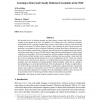13 search results - page 1 / 3 » Learning to detect malicious executables in the wild |
JMLR
2006
13 years 4 months ago
2006
We describe the use of machine learning and data mining to detect and classify malicious executables as they appear in the wild. We gathered 1,971 benign and 1,651 malicious execu...
KDD
2004
ACM
14 years 5 months ago
2004
ACM
In this paper, we describe the development of a fielded application for detecting malicious executables in the wild. We gathered 1971 benign and 1651 malicious executables and enc...
SICHERHEIT
2008
13 years 6 months ago
2008
Abstract: Client-side attacks are on the rise: malicious websites that exploit vulnerabilities in the visitor's browser are posing a serious threat to client security, comprom...
ICC
2007
IEEE
13 years 11 months ago
2007
IEEE
— We present a hybrid data mining approach to detect malicious executables. In this approach we identify important features of the malicious and benign executables. These feature...
ICECCS
2005
IEEE
13 years 10 months ago
2005
IEEE
The JavaScript language is used to enhance the clientside display of web pages. JavaScript code is downloaded into browsers and executed on-the-fly by an embedded interpreter. Br...

